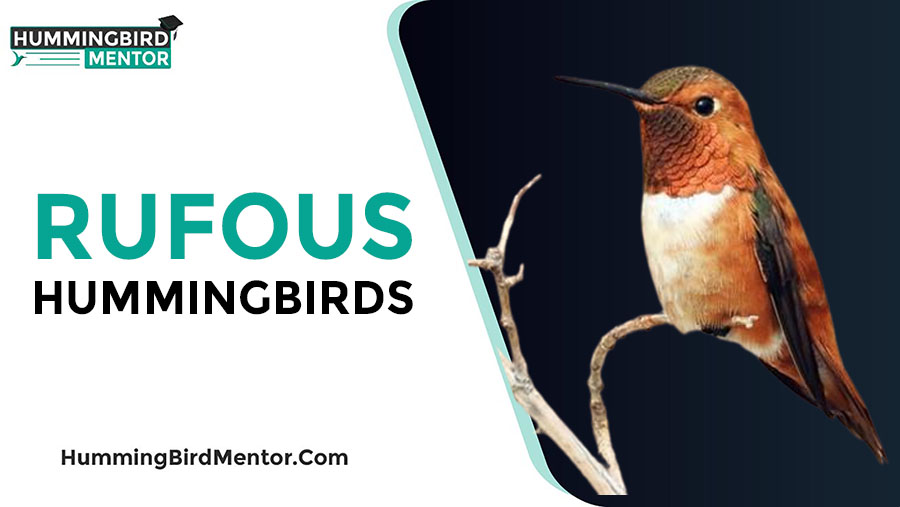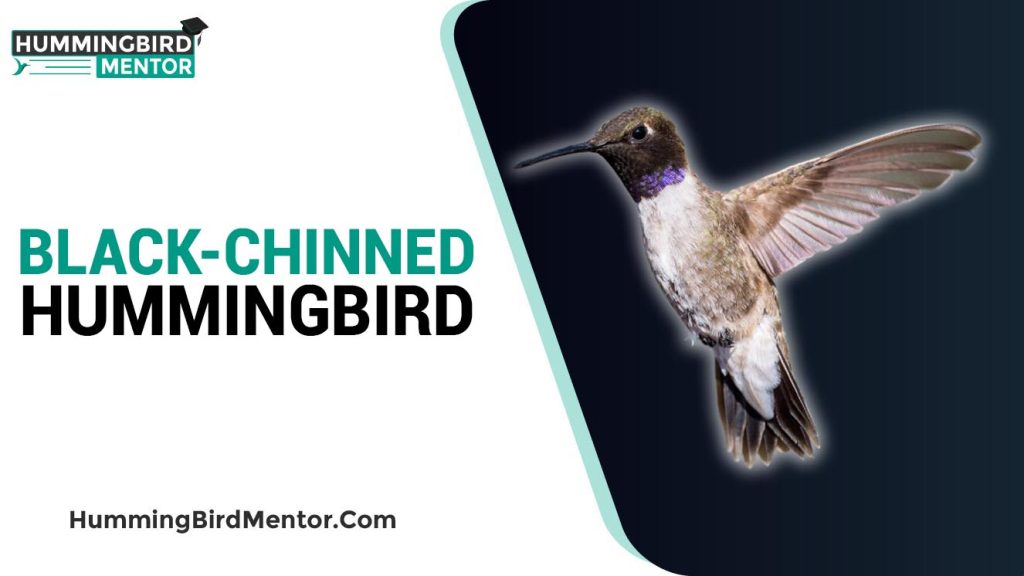Allen’s hummingbird is a species of hummingbird which normally breed in the western United States. It’s a small bird species reaching up to 3 to 3.5 inches in length. The male Allen’s hummingbirds have a green-back and forehead with rust-colored rump, tail, and flanks. Their throat is orange-red, which makes them slightly different from the female Allen’s hummingbirds. The Immature male Allen’s hummingbirds have the same color as the females.
The immature Allen’s hummingbirds are also extremely similar to the Rufous hummingbirds. They can only be separated from the Rufous hummingbirds with their tail feathers that are slightly different. You can’t easily distinguish the Allen’s and Rufous hummingbirds in the field without their good photographs. Let’s know more about Allen’s hummingbirds.
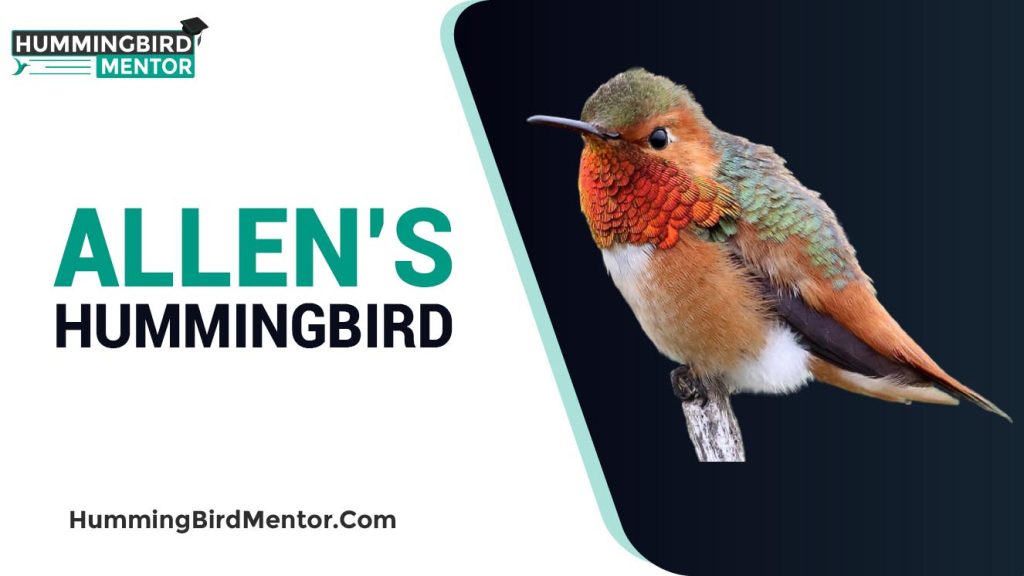
Scientific Name
The scientific name for Allen’s hummingbird is Selasphorus Sasin Sedentarius
Conservation
Allen’s hummingbirds are one of the most common species of hummingbirds, but their population decreased by 83% from 1970 to 2014. If their decline continues, they can lose another half of their current population in the next 17 years. This hummingbird species is not as adapted to the urban environment as some of the other species.
Size and Shape
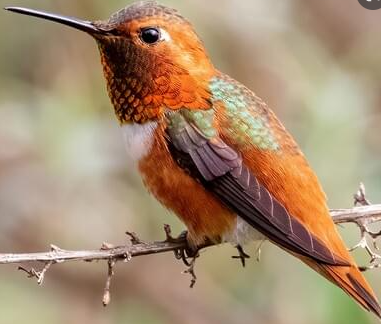 Allen’s hummingbirds are known for their small, compact, and stocky size and shape. Their bill is straight and almost equal in size to their head. Their tail feathers extend to pass their wings during perching, and the outermost tail feather is narrower than the rest. When you compare their size with some other hummingbird species, these are slightly larger than the Calliope hummingbirds. So, you can say that Allen’s hummingbirds are sparrow-sized or even smaller. Both of their sexes can have a length of 3.5 inches, with 0.1 oz weight and 4.3 wingspans.
Allen’s hummingbirds are known for their small, compact, and stocky size and shape. Their bill is straight and almost equal in size to their head. Their tail feathers extend to pass their wings during perching, and the outermost tail feather is narrower than the rest. When you compare their size with some other hummingbird species, these are slightly larger than the Calliope hummingbirds. So, you can say that Allen’s hummingbirds are sparrow-sized or even smaller. Both of their sexes can have a length of 3.5 inches, with 0.1 oz weight and 4.3 wingspans.
Color pattern
Overall, Allen’s hummingbirds are coppery orange and green. The adult males usually have a coppery tail, eye patch, and belly, which contrast with their bronze-green back and deep reddish orange gorget. Females and immature Allen’s hummingbirds have bronze-green above the paler coppery sides. Both males and females have a bronze spot on their throats. Females have slightly more spots than males and also have a reddish-orange in the center of their throat.
Behavior
Allen’s hummingbird’s flight is similar to the motion of a swinging pendulum as they have a frantic back and forth flight arc of about 25 ft. To attract the attention of the females, they also dive from 100ft during which their tail feathers emit a sharp flutter. Male Allen’s hummingbirds are very aggressive and often seen chasing the other males in their territory. They also chase the other hummingbird species, even known for attacking the other larger predatory birds such as kestrels and hawks.
Nest
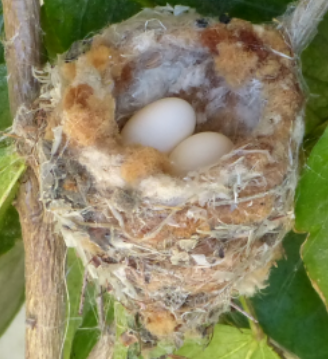 They construct their nest with the plant fibers, down, and weed stems and use the lichens and spider webs to give it a structure. They place their nest well above the ground on a tree branch, stalk, or stem of the plant. Females lay one or two eggs and incubate them for 15 to 17 days. After hatching, the young Allen’s hummingbirds leave their nest in three weeks. The mother feeds the young for a few more weeks, and then they leave them alone to feed themselves. They also have a high rate of metabolism like all the other birds and need frequent feeding. Mostly they get their required protein from flower nectar and small insects.
They construct their nest with the plant fibers, down, and weed stems and use the lichens and spider webs to give it a structure. They place their nest well above the ground on a tree branch, stalk, or stem of the plant. Females lay one or two eggs and incubate them for 15 to 17 days. After hatching, the young Allen’s hummingbirds leave their nest in three weeks. The mother feeds the young for a few more weeks, and then they leave them alone to feed themselves. They also have a high rate of metabolism like all the other birds and need frequent feeding. Mostly they get their required protein from flower nectar and small insects.
Habitat
Allen’s hummingbirds are commonly found in brushy woods, gardens, and meadows of coastal California, ranging from Santa north and southern coastal Oregon. They breed in coastal forests, scrubs, and chaparrals from California to southern Oregon. Since the 1960s, their population colonized the Palos Verdes Peninsula of Los Angeles County. Since then, much of their population has spread over Los Angeles and Orange Counties, south through San Diego County and east to the western end of Riverside County.
Migration
Allen’s hummingbirds usually migrate in small distances and are known as a medium-distance migrants. They usually breed along the coast from southern Oregon to Southern California and fly to central Mexico for winter in December. Their first spring migrants arrived on the northern edge in March, and their strength increased from mid-April to mid-May. They start their fall migration in mid-summer, and most of the birds in southwestern Oregon and California depart in August.
Songs and Calls
Allen’s hummingbirds produce different songs and call in different moods. Usually, they produce low chup. While the excited Allen’s hummingbirds produce the zeeee chuppity-chup.
Backyard tips to attract Allen’s hummingbirds
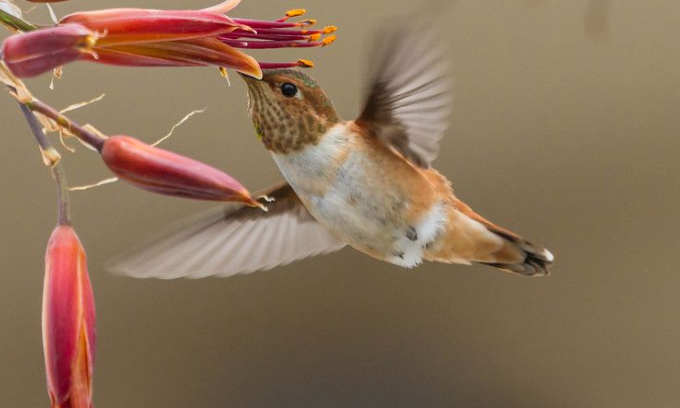
If Allen’s hummingbirds are present in your area, you can attract them with a sugar-water feeder. These nectar-filled feeders provide you with a great opportunity to watch them in your yard. To make perfect nectar, take one part of table sugar and dissolve it into four parts of water. Don’t use artificial coloring as it can harm hummingbirds. You can also add flowers in your yard to attract hummingbirds as they also increase the beauty of your backyard. The running water is also very attractive for hummingbirds. They love the flying drops of water.
Cool facts about Allen’s hummingbirds
- Male and female Allen’s hummingbirds use different territories during their breeding season. The male Allen’s hummingbirds set their territory in the open areas of the coastal scrub or chaparral and perched on the exposed branches. Females visit these areas for mating, but after mating, they head into the thickets or forest to build the nest to raise their young.
- Allen’s hummingbirds breed in the narrow strip of habitat along with coastal Oregon and California. Two subspecies also occur in their tiny range. One migrates to the small areas of Mexico during winter and the other stay in California year-round.
- Allen’s hummingbirds leave their wintering grounds early as compared to the other North American birds. Usually, they leave their wintering grounds as early as December to arrive in their breeding grounds in January.
- Allen’s hummingbirds control their body temperature with their feet. They put their feet up along their bellies in the cold and dangle their feet in soar temperatures to cool down their body temperature.
- In 2009, the oldest Allen’s hummingbirds were captured during the banding operations, having at least 5 years and 11 months of age.
How can you differentiate Allen’s hummingbirds from Rufous?
Allen’s hummingbirds are most likely the Rufous hummingbirds, it’s hard to differentiate sometime. Both have the same color pattern except for their back and rump. The Allen’s hummingbirds mostly have bronze-green back as compared to the copper back of the Rufous. Even some rare Rufous hummingbirds also have green feathers on their back.
What is the life span of Allen’s hummingbirds?
Allen’s hummingbirds can live up to 5 years. The oldest known Allen’s hummingbirds were 5 years and 11 months, which were found during a banding operation in California in 2009. This Allen’s hummingbird was banded in the same state in 2004.
Why is this species named Allen’s?
In 1877, this species was named Allen’s for the name of Charles Andrew Allen, who first identified this bird in California. This is the second smallest species after Calliope, which only grow up to 3 inches. You can easily locate Allen’s hummingbirds in the same garden along with Anna’s hummingbirds.
What is the difference between male and female Allen’s hummingbirds?
You can differentiate the male Allen’s hummingbirds from females as these are slightly different. The male Allen’s hummingbirds have rusty-orange flanks as compared to the Rufous-orange flanks of the female Allen’s hummingbirds. The male has a breast band or patch below the gorget. Both have greenbacks.
How to identify the young Allen’s hummingbird?
The young Allen’s hummingbirds look very similar to females. They have green backs and also look very close to females due to the same throat. But a tiny patch of red feathers on the female throat differentiates them from the young Allen’s hummingbirds. You can also differentiate the young Allen’s due to their dull color as compared to the females.
What are the favorite plants of Allen’s hummingbirds?
Allen’s hummingbirds love to get the natural nectar from the fresh flowers. Their favorite flowering plants include the Indian paint-brush, brush-monkey flower, twinberry honeysuckle, Penstemon, and Western columbine.
Where to find Allen’s hummingbirds?
You can locate Allen’s hummingbirds along the West Coast during the early spring. These birds arrive in the Chaparral and coastal scrub in early January. You can easily locate them on the top of the shrubs or listen to the bumblebee sounds in these areas. You can find them on the nectar feeders, especially during the migration period.
Conclusion
Allen’s hummingbirds are another common species of hummingbirds, which can reach up to 3 to 3.5 inches in length. They are known for their color pattern, which is mostly similar to the Rufous hummingbirds. The male Allen’s hummingbirds are slightly different from the female Allen’s hummingbirds. They are mostly found in brushy woods, gardens, and meadows of coastal California. You can attract them to your garden by offering fresh nectar feeders.
